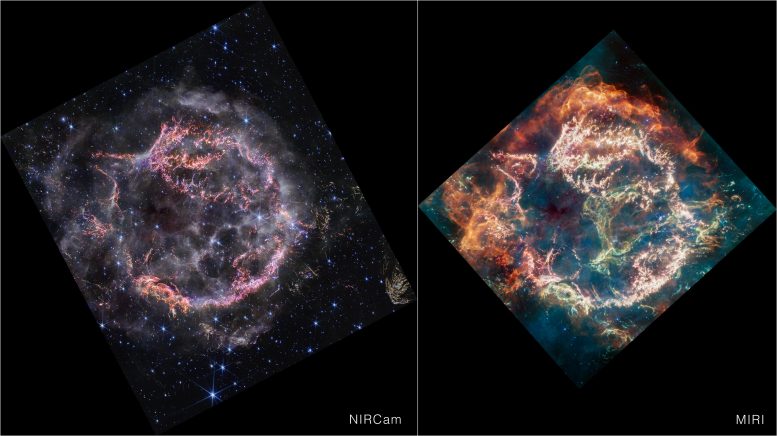In the vast expanse of space, celestial entities unfurl diverse dimensions of their conduct as they interact with varying wavelengths of light.
The most recent revelations are coming to light through the application of NASA’s state-of-the-art James Webb Space Telescope. The telescope’s current focus on the near-infrared has left scientists utterly astonished, unlocking a trove of previously undiscovered intricacies within the cosmic debris of Cas A.
The James Webb Space Telescope (JWST) has unveiled a fascinating discovery concerning a box-shaped cluster of impenetrable dust at the heart of the Milky Way Galaxy. Contrary to previous assumptions, this cloud, affectionately known as ‘the Brick,’ is not solely composed of gas, per a study. The research, featured in the Astrophysics Journal, highlights that ‘the Brick’ is also scattered with frozen carbon monoxide.

What is ‘the Brick’?
Earlier this month, The James Webb Space Telescope (JWST) made a significant revelation by identifying a considerable presence of carbon-monoxide ice within a vast cloud of molecular gas nicknamed “The Brick.” This cosmic structure, officially designated as G0.253+0.016, is situated near the central hub of our Milky Way galaxy.
In the expansive region astronomers term the Central Molecular Zone, ‘The Brick’ is part of a colossal assembly of nebulas, collectively amounting to amassing 60 million times that of our sun. The JWST’s detection sheds light on the intricate composition of this celestial giant, opening new avenues for understanding the dynamics within the heart of our galaxy.
What has the study asserted?
It identified 56,146 stars using the crowdsource package across all six filters. The study emphasizes that stars within and beyond ‘The Brick’ showcase remarkable absorption patterns in the F466N filter, a phenomenon attributed to a CO ice and gas blend.
In further substantiation of this assertion and to provide a valuable resource, the study introduces models illustrating the presence of CO gas and ice, along with CO2 ice, in the F466N, F470N, and F410M filters.
The intricate interplay between CO2 gas and ice significantly influences the observed colors of the stars, contributing to a deeper comprehension of the cosmic tapestry surrounding ‘The Brick.’
Webb’s Glimpse into Cas A’s Enigmatic Inner Shell
The James Webb Space Telescope’s (Webb) Near-Infrared Camera (NIRCam) captures a mesmerizing view of the Cassiopeia A (Cas A) supernova, presenting a resolution previously unattainable at these wavelengths. This heightened visual acuity peels back the layers, exposing intricate details of the expanding shell colliding with the stellar remnants.
Cas A is one of the most extensively examined supernova remnants in the cosmos. Over the years, various observatories, both ground-based and space-based—including NASA’s Chandra X-Ray Observatory, Hubble Space Telescope, and the retired Spitzer Space Telescope—have collaboratively woven a multiwavelength tapestry depicting the remnants of this stellar explosion.

However, the exploration of Cas A has now entered a new epoch. In April 2023, Webb’s Mid-Infrared Instrument (MIRI) initiated this next chapter, unraveling previously unseen and surprising features within the inner shell of the supernova remnant. Notably, many of these features elude detection in the new NIRCam image, prompting astronomers to delve into the mystery of their invisibility.
‘Like Shards of Glass’ – Webb’s Intricate View of Cas A
In infrared light, where our eyes cannot tread, image processors and scientists harness the power to translate these wavelengths into visible colors.
While the initial glance at the NIRCam image may suggest a subdued color palette compared to its MIRI counterpart, this discrepancy arises from the specific wavelengths at which the material emits light. Notably, the vibrant hues of bright orange and light pink dominate Webb’s newest image, representing clustered formations constituting the inner shell of the supernova remnant.

Webb’s unparalleled clarity allows for detecting minuscule gas knots composed of sulfur, oxygen, argon, and neon originating from the star. A fusion of dust and molecules resides within this gas, destined to become building blocks for future stars and planetary systems.
Some debris filaments, too diminutive for even Webb to resolve, hover on the scale of or smaller than 10 billion miles (around 100 astronomical units). To put this in perspective, the entire expanse of Cas A stretches across ten light-years or a staggering 60 trillion miles.
Why is this important?
The discoveries outlined in the study could wield significant implications for the scientific community’s future analysis of the region.
The study underscores that an increased presence of carbon dioxide within ‘The Brick’ can revolutionize the methodologies researchers employ when studying and gauging dark clouds in the central expanse of the Milky Way Galaxy.
Adam Ginsburg, an astronomer from the University of Florida, remarked on the current proximity to unraveling the mysteries concealed within ‘The Brick’ and pinpointing its mass distribution.
Accessing the James Webb Space Telescope (JWST) data in September of last year, Ginsburg and his colleagues harnessed the capabilities of the most potent space telescope ever constructed, anticipating unprecedented insights into the enigmatic world encapsulated by ‘The Brick.’












Comments 1